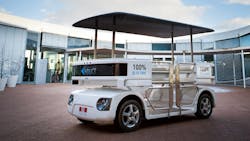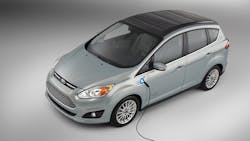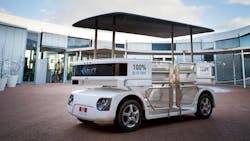Looking For A Ride To The 2014 Consumer Electronics Show
The 2014 Consumer Electronics Show (CES) in Las Vegas is just around the corner. I will be heading out there this weekend to see the latest and greatest technology from the new 4K Ultra HD televisions to the latest in automotive technology. Most of the announcements have to wait until CES opens but there are a couple previews we are able to talk about. We will be shooting videos of these at CES so check out the rest of our coverage of the show as it gets posted.
One neat concept car is Fords C-MAX Solar Energi (Fig. 1). It starts with a C-MAX Energi plug-in hybrid. I have driven one of these and we actually just bought a Ford Fusion Hybrid because the Energis were not available yet. The plug-in hybrid has a 621 mile range including 21 miles of all electric operation.
Figure 1. Fords C-MAX Solar Energi includes a solar panel array covered by Fresnel lens to augment the usual battery charge system that includes an on-board gas engine.
Related Articles
- It Takes A WaRPed Mind To Design Wearable Tech
- Gallery: Wearable Tech at CES 2014
- Gallery: Amazing Autos at CES 2014
The solar panel is not designed to provide all the power. It is only a 1.5 m2 array after all. It is designed to be used by parking in a space under a Fresnel lenses so it the angle of the incoming sunlight is less of an issue. The car will also move around to optimize power collection. On a good day the panels can provide about 8 kW. That is about the same as a 4 hour charge. Of course, there is always the question of whether it would make more sense to have the solar collection feed a battery that would charge when the car was plugged in instead.
How this will augment the need for a plug depends upon the driving requirements. Most of those looking at electric or hybrid, plug-in electric vehicles are likely to have daily requirements that are close to the electric-only limit of the vehicle so solar panels could make sense. It may even provide enough to take the car off the grid.
An electric vehicle that is closer to production is Induct Technologies Navia electric shuttle (Fig. 2). It is designed for pedestrian areas or private campuses.
Figure 2. Induct Technologies Navia electric shuttle holds 8 people but no driver. It is an autonomous vehicle.
The Navia is an autonomous vehicle that is equipped with laser scanners so it can avoid obstacles. It is designed to provide the same kind of service as a bus or train moving people between stops. We already use autonomous trains at many airports but the Navia does not require the rail-style infrastructure. It just needs a flat surface. The vehicles have a set of paths that would already be programmed in.
A fleet of Navia shuttles can support an area. More shuttles can be automatically added to the mix as the load increases. Likewise, shuttles can be parked as fewer people need to be moved around.
One fixed item is the induction charging unit that would be located at each stop. The car needs to come within 15-in where it is quickly recharged before moving onto the next stop.
So it is off to CES to see what kind of ride I can get.
About the Author
William Wong Blog
Senior Content Director
Bill's latest articles are listed on this author page, William G. Wong.
Bill Wong covers Digital, Embedded, Systems and Software topics at Electronic Design. He writes a number of columns, including Lab Bench and alt.embedded, plus Bill's Workbench hands-on column. Bill is a Georgia Tech alumni with a B.S in Electrical Engineering and a master's degree in computer science for Rutgers, The State University of New Jersey.
He has written a dozen books and was the first Director of PC Labs at PC Magazine. He has worked in the computer and publication industry for almost 40 years and has been with Electronic Design since 2000. He helps run the Mercer Science and Engineering Fair in Mercer County, NJ.
- Check out more articles by Bill Wong on Electronic Design
- Bill Wong on Facebook
- @AltEmbedded on Twitter


